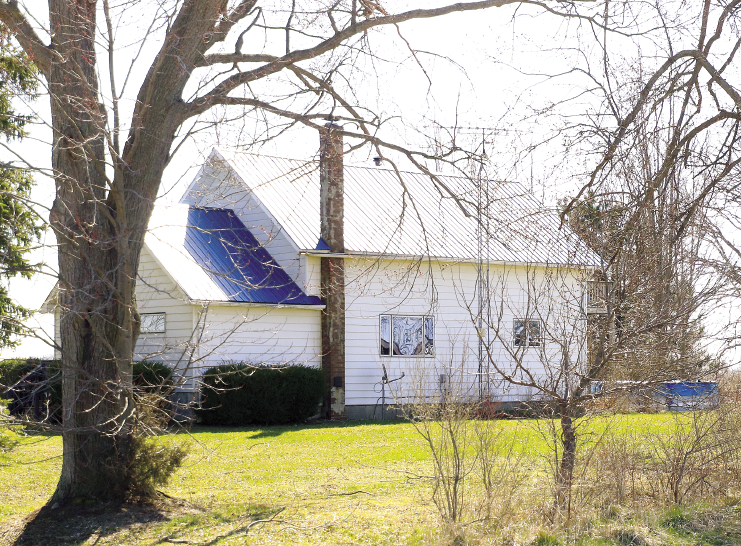Cash School Still Stands
By Jackie Salowitz
Tribune Recorder Leader
Marvin Bays was a past student of the school, but he first attended Ball School, which was about three miles from his parents’ farm. After a short stint at Ball School, Marvin hopped on the bus, attending Sandusky School through third grade. Marvin then got his learning at Cash School through eighth grade, and then went back to Sandusky.

While at Cash School, his teacher’s name was May Cash. Most times, Marvin would walk to school, but when the weather warmed up, he would ride his bicycle the little over a mile and a half. He enjoyed playing ball, and the students at Cash would play against other schools in the area.
He remembers how the teacher would call a certain grade up to the front of the class to teach them, and then after their lesson, they would go to the back of the room. Marvin said that Mrs. Cash was a strict teacher, she had a paddle that kept the kids in line, all she had to do was smack that paddle on a desk…
The kids brought a packed lunch to school, and water for the day came from an outside pump. There was no indoor plumbing, so bathrooms were outhouses.
He feels that he got a good education at Cash, with math being his favorite subject. Marvin graduated from Sandusky Schools, graduating sixth in his class. His three sisters all went to school in Sandusky, with his oldest sister only attending Cash School for one year.
Marvin also remembers a little store in the town of Cash, where they sold everything. He remembers going there to buy candy. He was disappointed when the store closed.
John Harding also attended Cash School, from K- seventh grade. The school closed, so he finished his education at Sandusky Schools. From going to a total of approximately 20 students in a whole school to 100 kids in a class was somewhat of an adjustment.
John had quite a walk to school, two miles. He said he doesn’t ever remember it bothering him, and often times there would be three other boys and three girls to walk with. On the way home, being typical kids, they would play in the ditches along the way, making the walk more fun. John also trapped muskrats, so on the way to school he would unset the traps, leaving his catch at a neighbors, picking them up on the way home. Sometimes John would ride his bike, and once in awhile would get a ride from the teacher.
Packing his daily peanut butter and jelly sandwich in a paper bag, often times his lunch would get a little soggy. Gloves would also get a little wet, Mr. Cash would have the woodstove going good when the kids arrived, so they would all put their gloves on the stove to dry out.
John started out with May Cash as a teacher, but then a young, unmarried teacher took her place, Sally Pritchett. After Cash School closed, she went on to teach at Maple Valley, where she eventually taught John’s kids. He remembers her driving a ‘55 Chevrolet. They very rarely had a substitute teacher, and very rarely had a snow day.
John said that their education wasn’t all about books, but that they also learned a lot of just worldly things. He felt that he received a good education in that one-room schoolhouse. After the kids received their lesson, they would go to the back of the classroom, and by the time they were back at the front as they rotated through the day, lessons were to be done. The teachers wanted the students to do well in school.
John remembers one time when teacher Sally Pritchett’s boyfriend stopped in at the school. She had gone to use the restroom, and when she had come back to the classroom, somehow the clock had changed to 4:30 p.m. (He had changed the time and the kids weren’t going to rat him out). So, school was dismissed as the day was over. Needless to say, parents were confused about why the children came home early that day, and a few calls were made to the teacher.
Playing ball was a lot of fun for the students, competing against other country schools. All the students would go to the games, with the younger kids not usually picked to play, as they wanted the older kids to participate, hoping for a win. They usually had the opportunity to play four or five times a year. The teacher and parents would load the kids up cars and take them to the games. The kids that didn’t participate in the games, would play Ante-I-Over (also known by other names), where kids would throw a ball over the roof of the school, with kids on the other side trying to catch the ball. They would also play hide-and-seek. Sometimes the good old merry-go-round would get a good workout, with all the young kids hopping on and the older kids spinning it around as fast as they could. Often times the kids would get off, staggering around because they were so dizzy, and sometimes even throwing up. The bigger kids thought it was funny, but not so much the teacher!
Pheasant hunting was also a popular thing to do, with the kids taking a day off for opening day. The limit was two pheasants a day, but John said they could have shot way more.
John’s dad and grandpa were instrumental in adding on to the schoolhouse, which was used as a furnace room and bathrooms. No more going outside to use the outhouses (does anyone know why there were three seats in them?)
The schoolhouse is now a home, where nail holes still remain in the hardwood floors, presumably where desks were nailed down.


